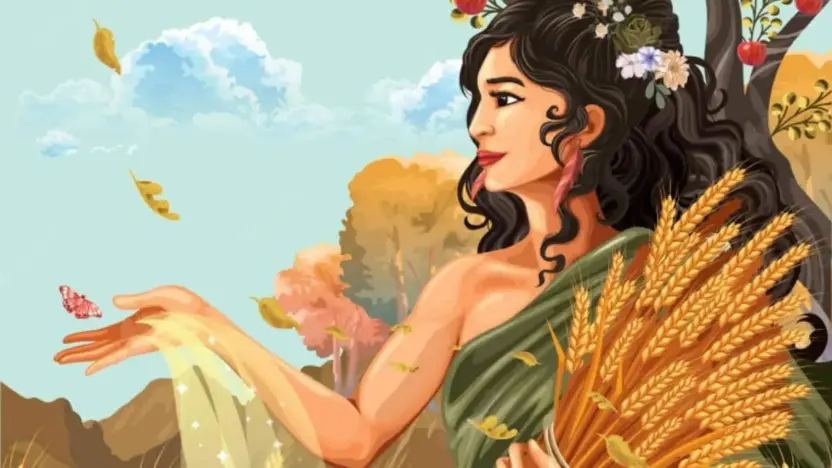In the rich tapestry of Greek mythology, Demeter holds a place of honor as the goddess of the harvest, agriculture, and fertility. Gifted with the power to bring life to the barren fields, she was deeply revered in a society that relied heavily on the earth’s bounty for survival. Yet, her story goes beyond her role as a life-bringer. It is interwoven with tales of love, loss, and the cyclical nature of life itself, encapsulating some of the most profound aspects of the human experience. This article delves into the lore surrounding Demeter, exploring the myths, her influence on ancient Greek culture, and her enduring legacy in contemporary society. Through the ebb and flow of seasons and her own personal trials, Demeter’s story carries potent lessons that resonate with us, even thousands of years after her tales were first told.
Origins and Family
In ancient Greek religion and mythology, Demeter is the second child of the Titans Rhea and Cronus, and sister to Hestia, Hera, Hades, Poseidon, and Zeus. Like her siblings, she was swallowed by her father as an infant and later rescued by Zeus.
Emerging from the depths of her father’s belly, Demeter’s rescue by Zeus marked the beginning of her divine journey, where she would emerge as a beacon of fertility, hope, and the eternal bond between mother and child.
This family connection, coupled with her miraculous deliverance, underscores the profound significance of Demeter in the divine pantheon and sets the stage for her extraordinary journey.
As Demeter emerged from the depths of her father’s belly, she carried with her a newfound resilience and determination that would shape her path as a goddess of abundance and nourishment.
The miraculous rescue by Zeus not only saved Demeter from her father’s grasp but also ignited a flame within her, propelling her to become a powerful symbol of the eternal bond between mother and child, a beacon of hope for all those who depend on the earth’s bountiful harvest.
The Abduction of Persephone
One of the most notable Homeric Hymns, the Homeric Hymn to Demeter, tells the story of Persephone’s abduction by Hades and Demeter’s desperate search for her beloved daughter.
Picture a serene field where Persephone was picking flowers when Hades, with Zeus’ permission, abducted her to the Underworld. Demeter’s grief and anguish upon discovering her daughter’s disappearance were so profound that crops withered, and the Earth became barren, plunging mortals into a deadly famine.
In her anguish, Demeter’s tears transformed into delicate blossoms, their petals reflecting the sorrow that enveloped the world, further deepening the poignancy of her daughter’s abduction.
Demeter’s Quest for Persephone
Driven by her undying love for Persephone, Demeter embarked on a relentless quest to find her missing daughter. She searched every corner of the Earth, desperately seeking any clue that could lead her to Persephone’s whereabouts.
It was during this time that Demeter encountered Helios, the sun god, who revealed the truth about Persephone’s abduction. Armed with this knowledge, Demeter confronted Zeus, demanding the return of her daughter.
In her confrontation with Zeus, Demeter’s fury blazed like an unstoppable wildfire, as she demanded the return of her daughter, unyielding in her resolve to reunite their broken bond.
The Compromise and the Seasons
Zeus, faced with the devastating consequences of Demeter’s grief, intervened and negotiated Persephone’s release from the underworld.
However, due to Persephone having consumed food from the Underworld, she could not remain with Demeter permanently. A compromise was reached, Persephone would spend a portion of each year in the Underworld with her husband, Hades, while the remaining time would be reunited with her mother.
This agreement explained the cycle of seasons, with Demeter’s joy and renewed vitality bringing life back to the Earth upon Persephone’s return.
Furthermore, the compromise between Demeter and Hades not only governed Persephone’s presence in the Underworld but also symbolized the delicate balance between life and death, showcasing the intricate dance of nature’s rhythms and the eternal cycle of renewal.
As the seasons changed, Demeter’s sorrow transformed into hope, and her joyous reunion with Persephone became a beacon of rejuvenation, painting the world in vibrant colors and breathing life into the once barren landscapes.
Also Read: Most Famous Mythology Characters With Multiple Heads



